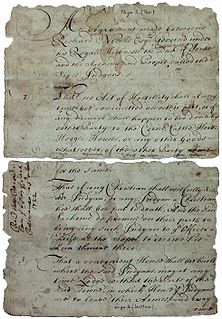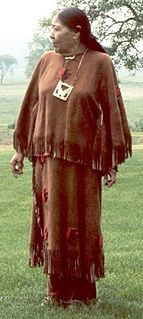
The Lenape, also called the Leni Lenape, Lenni Lenape and Delaware people, are an indigenous people of the Northeastern Woodlands, who live in Canada and the United States. Their historical territory included present-day New Jersey and eastern Pennsylvania along the Delaware River watershed, New York City, western Long Island, and the Lower Hudson Valley. Today, Lenape people belong to the Delaware Nation and Delaware Tribe of Indians in Oklahoma; the Stockbridge-Munsee Community in Wisconsin; and the Munsee-Delaware Nation, Moravian of the Thames First Nation, and Delaware of Six Nations in Ontario.

The Ramapough Mountain Indians, also known as the Ramapough Lenape Nation or Ramapough Lunaape Munsee Delaware Nation, are a group of approximately 5,000 people living around the Ramapo Mountains of Bergen and Passaic counties in northern New Jersey and Rockland County in southern New York, about 25 miles (40 km) from New York City. They were recognized in 1980 by the state of New Jersey as the Ramapough Lenape Nation but are not federally recognized. Their tribal office is located on Stag Hill Road on Houvenkopf Mountain in Mahwah, New Jersey. Since January 2007, the chief of the Ramapough Lenape Nation has been Dwaine Perry.

Lenapehoking is a term for the lands historically inhabited by the Native American people known as the Lenape in what is now the Mid-Atlantic United States. Much of this land is now heavily urbanized and suburbanized.

Moravian 47 is an Indian reserve located in Chatham-Kent Ontario with an area of 13 km². It is occupied by the Delaware Nation at Moraviantown First Nation, a part of the Munsee branch of the Lenape, and is commonly known as Moravian of the Thames reserve. The resident registered population is 457, with another 587 band members living off the reserve.

The Gnadenhutten massacre, also known as the Moravian massacre, was the killing of 96 Christian Delaware by colonial White American militia from Pennsylvania on March 8, 1782 at the Moravian missionary village of Gnadenhutten, Ohio during the American Revolutionary War. More than a century later, President Theodore Roosevelt would call the massacre "a stain on the frontier character that time cannot wash away".

The Delaware languages, also known as the Lenape languages, are Munsee and Unami, two closely related languages of the Eastern Algonquian subgroup of the Algonquian language family. Munsee and Unami, spoken aboriginally by the Lenape people in the vicinity of the modern New York City area in the United States, including western Long Island, Manhattan Island, Staten Island, as well as adjacent areas on the mainland: southeastern New York State, eastern Pennsylvania, New Jersey, Connecticut, Maryland, and coastal Delaware.

The Delaware Nation, also known as the Delaware Tribe of Western Oklahoma and sometimes called the Absentee or Western Delaware, based in Anadarko, Oklahoma is one of three federally recognized tribes of Delaware Indians in the United States, along with the Delaware Indians based in Bartlesville, Oklahoma and the Stockbridge-Munsee Community of Wisconsin. Communities also reside in Canada.

Unami is an Algonquian language spoken by the Lenape people in the late 17th century and the early 18th century, in what then was the southern two-thirds of New Jersey, southeastern Pennsylvania and the northern two-thirds of Delaware, but later in Ontario and Oklahoma. It is one of the two Delaware languages, the other being Munsee. The last fluent speaker in the United States, Edward Thompson, of the Delaware Tribe of Indians, died on 31 August 2002. His sister Nora Thompson Dean (1907–1984) provided valuable information about the language to linguists and other scholars.
The Christian Munsee were a group of Lenape native American Indians, primarily Munsee-speaking, who converted to Christianity, following the teachings of the Moravian missionaries. The Christian Munsee were also known as the Moravian Munsee or the Moravian Indians or, in context, simply the Christian Indians.

The Unalachtigo were a purported division of the Lenape, a Native American tribe whose homeland Lenapehoking was in what is today the Northeastern United States. They were part of the Forks Indians.
The Nanticoke Lenni-Lenape people are a tribal confederation of Nanticoke of the Delmarva Peninsula and the Lenape of southern New Jersey and northern Delaware. They are recognized by the state of New Jersey, having reorganized and maintained elected governments since the 1970s. They have not yet achieved federal recognition.
Minsi may refer to several articles:
Mahican is an extinct language of the Eastern Algonquian subgroup of the Algonquian language family, itself a member of the Algic language family. It was spoken in the territory of present-day eastern New York state and Vermont, by the Mahican people.

The Esopus tribe was a tribe of Lenape (Delaware) Native Americans who were native to Upstate New York, specifically the region of the Catskill Mountains. Their lands included modern-day Ulster and Sullivan counties.

The Delaware Tribe of Indians, sometimes called the Eastern Delaware, based in Bartlesville, Oklahoma, is one of three federally recognized tribes of Delaware Indians in the United States, along with the Delaware Nation based in Anadarko, Oklahoma and the Stockbridge-Munsee Community of Wisconsin. More Lenape or Delaware people live in Canada.
Moraviantown may refer to:

The Minisink or Minisink Valley is a loosely defined geographic region of the Upper Delaware River valley in northwestern New Jersey, northeastern Pennsylvania and New York.









